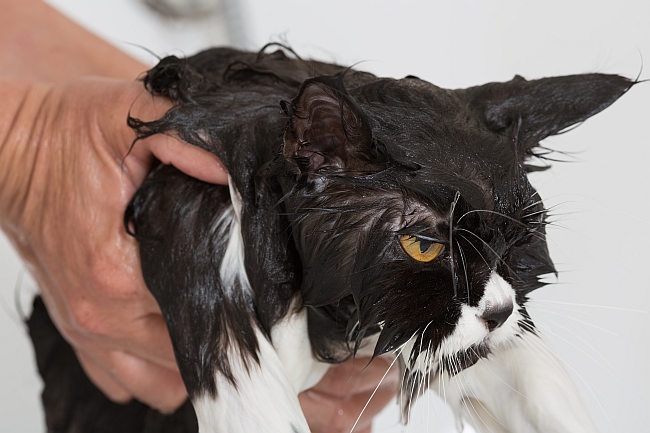
Being wet is mostly unpleasant for cats. Unlike dogs, felines do not enjoy romping around in the water (which fortunately also decreases the chances of you coming home to muddy floors and furniture from a pet playing in the rain!). When cats get wet, their fur becomes water logged, making them heavy and uncomfortable. The top layer of fur is water resistant on a cat, but when the coat is soaked, it becomes like a heavy blanket, limiting their agility. While the steps on How to Bathe Your Cat might be straight-forward enough, here are some helpful tips to help your cat ENJOY (or at least survive) the process without any pain, blood, sweat, or tears!
- Begin bathing your kitten when he is very young. This will help accustom him to being handled and restrained, so that when bath time rolls around, he will be easier to work with.
- Let your cat play in the water. At certain intervals before you attempt to bath your cat, fill the bath or sink with 2 inches of warm water and let your cat have the bathroom all to himself to play, roam scamper, and become familiar with the warm water. When a cat has a chance to investigate something without pressure, and explore on his own terms, it will make the bath seem less foreign and threatening when he has to stand in it with your help.
- Be strategic with timing. Don’t bathe your cat just after a playful game with the remote mouse. Let him calm down, and cool off before you introduce him to the next event. It is best to give a cat a bath when he is drowsy or well refreshed from a nap.
- Use Catnip. The first rule here is, be sure you know the effect catnip has on your kitty. When exposed to catnip, some felines get wired, defensive and almost wild in the way they blabber and stumble around. However, for the most part, cats tend to become drowsy and relaxed when they have been around catnip. If this is the case, use the herb to relax your cat, by rubbing a little bit of catnip on his nose and face before bathing him.
- Take your cat into the show and wear a bathing suit while you wash him. Some cats become alarmed when they are lowered into a bathtub or sink, rather than just washed on an equal surface with their owner.
- Place a towel on the bottom of the tub where your cat can grip with his paws. This will help him feel some element of control and stability while he is being bathed.
- Distract him with a toy. Bring in a bright ball or rubber fish he can stare or paw at. Though the primary goal is to keep your cat still, something as small and as interesting as a toy might engage his focus, and help him stop squirming.
- Apply pressure to the back of the neck. While this might seem absurd at first, note that cats are carried by their mothers at the back of their necks. The term for this kind of soothing hold is called “clipnosis” or pinch-induced behavioral inhibition (PIBI). Several cat owners have reported that during a bath, if the kitty is held by the back of his neck, the response was a more relaxed feline, who would in some cases purr with contentment. If you find bathing is a battle, then employ the clipnosis technique.
- Be brief! If the kitten is miserable, don’t keep him cold and bedraggled needlessly. Wash him and efficiently as you can, and give him plenty of treats and snuggles at the end.
If getting him into the tub is still a real struggle, you can always use antibacterial pet care wipes, or use a sponge and rub down your cat’s fur. Handling him will make your pet more approachable and easier to manage on trips to the vet or on other methods of transportation. Though it might feel like a battlefield every time it’s bath day, try to keep practicing gently and patiently with your cat. If you are calm and consistent about bath time, who knows? Your cat might come around and decide he doesn’t hate bathing all that much!

